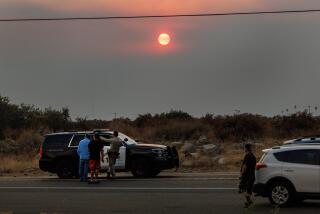Mystery Cause of Carbon Monoxide in 4 Cities Sought
Air quality experts and an auto maker initiated a joint study this week to find out why abnormally high carbon monoxide levels plague an area of Southeast Los Angeles County that includes the cities of Lynwood, South Gate, Bell and Compton.
“In that area last year,” said Bill Kelly, spokesman for the South Coast Air Quality Management District, “we had 51 days that exceeded the federal standards, so there is something going on down there.”
The study is being done by General Motors Corp., the state Air Resources Board and the South Coast Air Quality Management District in the area bounded by Slauson Avenue and by three freeways--the Harbor, Long Beach and Artesia.
Over the next three months, scientists will study everything from wind direction to traffic flow in an effort to determine why carbon monoxide levels there are often double those in nearby monitoring areas, even though auto exhaust emissions--the major cause of carbon monoxide--have sharply dropped throughout the state since 1968. That was the year California dictated pollution controls for auto makers.
Carbon monoxide is dangerous to people with heart and respiratory problems because it inhibits the blood’s ability to carry oxygen. It hits its highest levels in the cool winter months, forming around areas with high traffic volume or congestion. Summertime smog, on the other hand, features high ozone levels that cover wide areas.
There are 37 air quality monitoring areas in the Southland, Kelly said, but the area under study has the worst concentrations of carbon monoxide. The federal health standard is 9.5 parts per million during an eight-hour period, Kelly said. Carbon monoxide levels exceeded that level on 51 days in 1988, he said. The highest reading in any one period was 32 parts per million.
By comparison, in an adjacent area that has the region’s second highest carbon monoxide levels, violations were recorded on only 26 days. That area runs west from Hawthorne to Marina del Rey and then south along the coast to San Pedro. The highest reading in that area last year was 23 parts per million.
“The idea is that in those areas,” Kelly said, “there are some peculiar circumstances that are causing the high carbon monoxide concentrations.”
It is known, he said, that the Lynwood and Hawthorne monitoring areas, as they are called, have a “surface-level inversion.” When the ground cools off at night, he said, the air layer closest to the ground also cools and holds on to carbon monoxide that is emitted when cars start moving in the morning.
However, that does not explain why carbon monoxide levels at the Lynwood monitoring station are double the levels at stations in other monitoring areas, he said. Places with consistently high levels of carbon monoxide are called “hot spots” and they have been found in Spokane, Wash.; New York City, and Denver. This latest study will augment one done last winter by the University of Denver.
Eight research teams, including one from Denver, will use weather balloons and sophisticated measuring instruments to monitor the area’s weather conditions, including wind direction and speed. The scientists will also chart traffic volume and speed.
Things such as train traffic, fast-food drive-up windows or space heaters could be contributing to the carbon monoxide problem, Kelly said. Trains give off some carbon monoxide, as do space heaters when they are not properly adjusted, he said. Drive-up windows concern air quality experts because idling cars emit larger levels of carbon monoxide than moving vehicles.
During the study, about 75 air monitoring devices, a 150% increase over the usual number, will be placed throughout the entire Southland air basin. Most of the devices will be in the Lynwood and Hawthorne areas, but others will go elsewhere to serve as the scientific control group for the study. General Motors will hire people to drive two specially equipped cars to measure changes in carbon monoxide emissions under different driving conditions, such as rapid acceleration and various speed levels.
“(We’re) interested, believe it or not, in clean air and have been for years,” said Bill Ott, a spokesman for General Motors. “We’ve been working with various government agencies, be they state, regional or federal, for many years.”
The study will cost $510,000 with the Air Resources Board contributing $350,000 and the air quality district paying $60,000. About $100,000 will come from General Motors. Results of the study are not expected for about a year.
More to Read
Sign up for Essential California
The most important California stories and recommendations in your inbox every morning.
You may occasionally receive promotional content from the Los Angeles Times.










